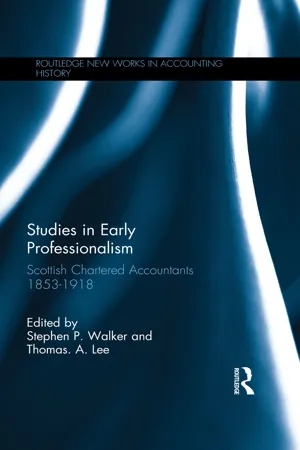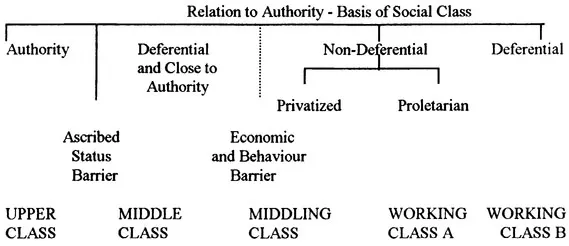
eBook - ePub
Studies in Early Professionalism
Scottish Chartered Accountants 1853-1918
- 384 pages
- English
- ePUB (mobile friendly)
- Available on iOS & Android
eBook - ePub
Studies in Early Professionalism
Scottish Chartered Accountants 1853-1918
About this book
This text aims to provide an in-depth review of recent historical research on the emergence and maturation of institutionalized public accountancy in Scotland from the mid-nineteenth century onwards. Individual contributions cover a range of historical studies including the original foundations and founders, the early competitive struggles with other bodies, the nature of Victorian public practice, individual successes and failures, and the gender issue.
Frequently asked questions
Yes, you can cancel anytime from the Subscription tab in your account settings on the Perlego website. Your subscription will stay active until the end of your current billing period. Learn how to cancel your subscription.
At the moment all of our mobile-responsive ePub books are available to download via the app. Most of our PDFs are also available to download and we're working on making the final remaining ones downloadable now. Learn more here.
Perlego offers two plans: Essential and Complete
- Essential is ideal for learners and professionals who enjoy exploring a wide range of subjects. Access the Essential Library with 800,000+ trusted titles and best-sellers across business, personal growth, and the humanities. Includes unlimited reading time and Standard Read Aloud voice.
- Complete: Perfect for advanced learners and researchers needing full, unrestricted access. Unlock 1.4M+ books across hundreds of subjects, including academic and specialized titles. The Complete Plan also includes advanced features like Premium Read Aloud and Research Assistant.
We are an online textbook subscription service, where you can get access to an entire online library for less than the price of a single book per month. With over 1 million books across 1000+ topics, we’ve got you covered! Learn more here.
Look out for the read-aloud symbol on your next book to see if you can listen to it. The read-aloud tool reads text aloud for you, highlighting the text as it is being read. You can pause it, speed it up and slow it down. Learn more here.
Yes! You can use the Perlego app on both iOS or Android devices to read anytime, anywhere — even offline. Perfect for commutes or when you’re on the go.
Please note we cannot support devices running on iOS 13 and Android 7 or earlier. Learn more about using the app.
Please note we cannot support devices running on iOS 13 and Android 7 or earlier. Learn more about using the app.
Yes, you can access Studies in Early Professionalism by Stephen P. Walker,Thomas A. Lee in PDF and/or ePUB format, as well as other popular books in Business & Business General. We have over one million books available in our catalogue for you to explore.
Information
Part 1
Formation Events
Chapter 1
Professional Formation: The Case of Scottish Accountants
Keith M Macdonald
Introduction
The study of the rise of an occupational group is important to the continuing debate on the nature and bases of social stratification in industrial society.
The battle-lines in this debate have been drawn between the neo-Marxists who are concerned with working out how to draw class boundaries that make sense of contemporary stratification while still adhering to the structural principles of class laid down by Marx over 100 years ago,1 and the Weberians who argue that the reality of social stratification requires the analysis of 'social closure' based not only on property in the means of production but on other criteria as well.2 The most important of these criteria is 'credentialism', which is seen as being of the essence of the 'collective social mobility',3 of 'professions' (although Parkin regards it rather differently, as part of bourgeois individualism).
Actual empirical studies of stratification, however, are usually interested in individual social mobility, where class is represented entirely by occupation (for instance, Goldthorp4), although the study of professions does provide a counter-balance with its concern with collective social mobility (e.g. Parry and Parry,5 and Larson.6)
Historical studies of the present kind are important because they give us an opportunity to see how an occupational group deploys its resources in its struggle for collective social mobility.
Collective social mobility
Larson's work has provided an important stimulus in recent years and the present study makes use of her two central concepts of 'collective social status' and 'market control'. However, there is little attempt either by Larson (or by other writers on this topic) to locate the aspiring occupations at all clearly in the stratification system of the nineteenth century. This tends to be regarded on a common sense basis as being a class society because it is the archetypal capitalist industrial society. The present study on the other hand is set in the context of recent historical work on nineteenth-century stratification, particularly Neale's7 attempt to adapt modern theories of social class (especially Dahrendorf8) to the study of social mobility in the mid-nineteenth century.
A general outline of Larson's work may be presented by quoting and summarizing certain passages:
Professionalism is ... an attempt to translate one order of scarce resources - specialist knowledge and skills - into another - social and economic rewards. To maintain scarcity implies a tendency to monopoly: monopoly of expertise in the market, monopoly of status in a system of stratification.
Professionalisation (is) the process by which producers of special services (seek) to constitute and control a market for their expertise. Because marketable expertise is a crucial element in the structure of modern inequality, professionalisation appears also as a collective assertion of special social status and as a process of collective upward social mobility.9
The nineteenth century development of professionalism constituted a new form of structured inequality that differed both from the model of aristocratic patrons and gentlemanly clients10 and from the model of capitalist entrepreneurs and property in the means of production. Its central principle of legitimacy rested on education and credentialing, leading to socially recognized expertise. Important elements in the development of professions are however the conflicts between this new principle and those of aristocracy and entrepreneurship.
This outline contains two analytical elements: market control and collective social status. These two aspects are analytically distinct although on the whole they refer to much the same empirical material (the actions and the pronouncements of norms and values by individuals, firms and associations, for example).
The other element is collective social status and mobility. 'The market', said Max Weber,11 'knows nothing of honour'. But as he goes on to discuss, those who are successful in the rational, nonaffective market normally wish to be well-regarded and looked up to by their fellow citizens and therefore attempt to convert economic success into high social status.
For Larson, however, the connection is of a different order, because looking at collective social mobility it is apparent that many (if not all) of the means of market control are also the means to the other aspect of the professional 'project', namely status.
When an occupation successfully defines and delimits its area of expertise, its market and its membership it establishes a collective social status, and the efforts of the occupational association tend directly and indirectly to emphasize the socially valued and rewarded characteristics. In doing so they probably achieve for the members upward social mobility and operate the mechanism that Parry and Parry,12 Parkin,13 and others see as the most important by which middle class groups define and maintain their position, namely 'closure'.
Nineteenth century stratification
Any discussion of collective social mobility must be set against a background of the social stratification of the period in question, otherwise the analysis is going to rely on some kind of 'common sense' history. The examination of the emergence of any profession is therefore immediately presented with the problem that in most cases the structure of society was in a state of change during the period of that emergence and that any such process was itself part of the change. The development of the accountancy profession is a case in point because between 1800 (when there seem to have been about a dozen men in London calling themselves accountants) and 1880 (when a Royal Charter created the Institute of Chartered Accountants in England and Wales and 1200 were admitted) major changes in the structure of society had occurred.
In 1800 many aspects of the old order prevailed and many historians (e.g. Perkin14) emphasize that two-thirds of the population still lived in the countryside and that many of the pre-steam factories 'were self-conscious models of paternal benevolence and discipline, ideal examples of the old society in miniature'.15
The old society, then was a finely graded hierarchy of great subtlety and discrimination, in which men were acutely aware of their exact relation to those immediately above and below them, but only vaguely conscious except at the very top of their connections with those of their own level.16
This continuum was held together by patronage in a great variety of forms.
'Vertical friendship', a durable two-way relationship between patrons and clients permeating the whole society, was a social nexus peculiar to the old society. Less formal and inescapable than feudal homage, more personal and comprehensive than the contractual employment relationships of capitalist 'Cash Payment'.17
Within thirty or forty years the dramatic social changes of rapidly advancing industrialism had made themselves felt. The working class had taken on its characteristic form18 and contemporary sociological models of class can be usefully applied.19,20 However two important observations must be noted before assuming that the social stratification system in which Accountancy emerged was essentially modern. The first point is made by Neale who claims that as compared with contemporary British class structure the following five-class model should be adopted.

FIGURE I Five-class model Based on Neale (1972)
The five classes are made up as follows:
- Upper class: aristocrat, landholding, authoritarian, exclusive.
- Middle class: industrial and commercial property-owners, senior military and professional men, aspiring to acceptance by the upper class.
- Middling class: petit bourgeois, aspiring professional men, other literates and artisans; individuated or privatized like the middle class but collectively less deferential.
- Working class A: industrial proletariat in factory areas, workers in domestic industries, collectivist and non-deferential.
- Working class B: agricultural labourers, other low-paid non-factory urban labourers, domestic servants, urban poor, deferential and dependent.
One should note in this model the distinction between a traditional deferential middle class and an aspiring privatized 'middling class'. If one reads this scheme in conjunction with the findings of Foster21 it seems likely that these aspirants as they moved up either allied themselves with the 'county' or saw themselves as part of the urban (and ultimately national) bourgeoisie and stayed closer to their radical origins.
The second major point is that during the past decade research into nineteenth century stratification especially of elites has led historians to modify the usual history book view that Victorian society became dominated by the newly wealthy capitalist manufacturer, with the Reform Act of 1832 as the turning point. The work of Arnstein22 and Rubinstein23 show that the really wealthy were not in manufacturing, but in commerce and that they tended to be associated with the landed aristocracy, who continued to dominate the political arena: in the 60 years following the Reform Act only two cabinets had less than 50 per cent aristocr...
Table of contents
- Cover
- Title
- Copyright
- Contents
- Acknowledgments
- Introduction: Early Scottish Professionalism in Accountancy
- PART 1: FORMATION EVENTS
- PART 2: POST FOUNDATION EVENTS